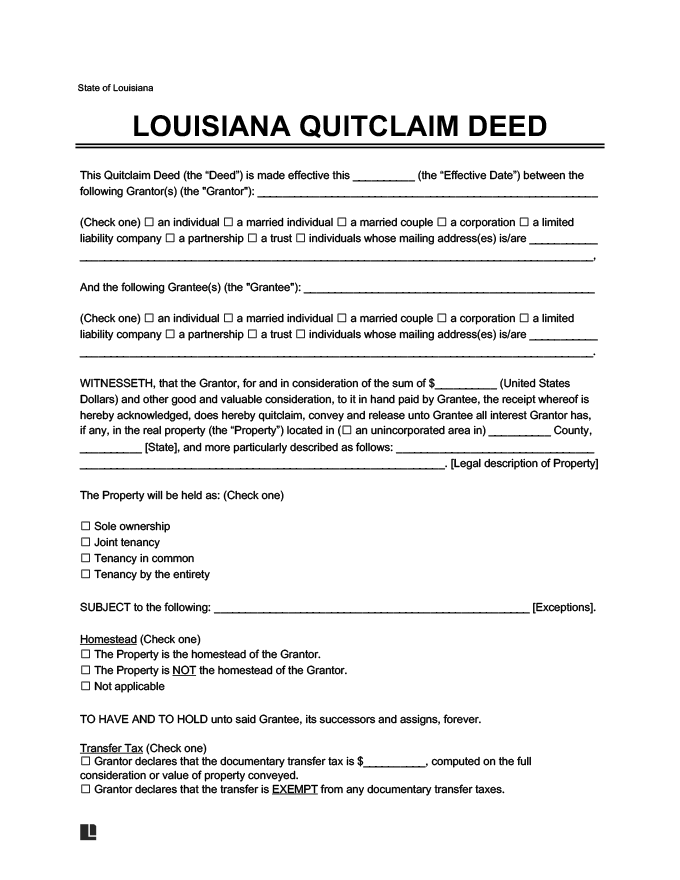A quitclaim deed in Louisiana transfers property from one entity to another without any warranty on the title. This means that any risks associated with the title, such as liens or encumbrances, become the responsibility of the new property owner.
Quitclaim deeds are usually used to transfer property between entities with a pre-existing relationship of trust or to correct any defects in the original title.
Legal Framework
In Louisiana, the legal framework for property transactions, including those involving quitclaim deeds, is governed by state-specific laws. The state’s approach to property law is unique because it is based on the civil law system, unlike the common law system used in the rest of the United States.
Legal Description
Including an accurate legal description of the property being transferred is crucial. This description typically encompasses the property’s boundaries and any other details that identify the specific piece of real estate, ensuring that the property can be identified from the deed alone.
Signing Requirements
According to L.A. Civil Code Art. 1833, a quitclaim deed needs to be signed by two witnesses in the presence of a notary. This designates a quitclaim deed as an “authentic act” under state law. The document needs to be signed by the grantor but does not necessarily have to be signed by the grantee.
Terminology
Without Warranty (Sans Garantie): This phrase can be included in acts of sale or donations to indicate that the seller or donor is not providing any warranty regarding the title or condition of the property being transferred. This is akin to the “no warranty” aspect of quitclaim deeds.
Encumbrances (Charges ou Servitudes): Refers to any liens, debts, or other burdens on the property. In the context of a transfer without warranty, the new owner takes the property subject to any existing encumbrances.
Additional Documents
According to L.A. Code 9:3198, sellers must file a property disclosure statement at the time of property transfer that informs buyers of defects or adverse conditions on the premises. The disclosure statement should include any known defects with the property or the property title.
Filing
Under L.A. Civil Code Art. 517, a property transfer is only valid to a third party once it has been filed in the parish where the property is located. That may mean visiting the clerks of court in person, mailing in the documents, or, in some parishes, using e-recording services. Check the website for the parish where you need to file the deed in order to determine its requirements.
Validity Requirements
As per CC 3352(A) and § 844(A)(1)(i), the deed should be legible, readable, and easy to understand. While Louisiana will accept documents that do not meet those guidelines, adhering to them can make the document easier to interpret and ensure its accuracy. Legibility suggestions include:
- White, legal-sized paper (8 1/2 x 14 inches)
- Double-spaced
- Margins of at least 3/4 inch, but no more than 1 1/4 inches, on the left, right, and bottom
- Margins of no less than 1 12 inch, but no more than 2 inches, on the top of each page
- Metal fasteners, including staples, on at least two places in the top margin of multi-page documents
- 11 or 12-point fonts
- Consecutively numbered pages
Content Requirements
In order to be considered valid, a quitclaim deed must contain several pieces of information. These include:
- The name and address of the grantor (the party giving or selling the property)
- The name and address of the grantee (the party taking possession of the property)
- A legal description of the property (which includes the parcel number, the boundaries of the property, and any other vital information about the property in addition to the address)
- The consideration exchanged for the property, if any
Notably, a quitclaim deed should not contain any mention of warranty of title, promises related to the title, or guarantees that the title is clear. These would fall under other deed types.
Quitclaim Deeds vs. Other Property Transfer Methods
| Quitclaim Deed | Conveys the current owner, or grantor's, interests in the property without warranty. |
| Special Warranty Deed | Conveys property ownership with only a special warranty on the property. Usually, that warranty covers only the time when the current owner possessed the property. |
| General Warranty Deed | Conveys property ownership with full warranty of title that covers any potential defects, including liens, unpaid property taxes, encumbrances, etc. |
| Life Estate Deed | Creates two interests in a property: a life interest, which belongs to the current owner or grantor until death; and a remainder interest, which transfers ownership of and all rights to the property to the new owner, or grantee, after the death of the current owner. A life estate deed is irrevocable without the permission of the grantee. |
| Ladybird Deed | A variation of a life estate deed, also known as an enhanced life estate deed. Creates both a life interest and a remainder interest in the property, but allows the grantor to maintain control over the property, including the ability to mortgage or sell it. |
| Transfer on Death (TOD) Deeds | Transfers property ownership only following the death of the current owner, or grantor; does not give the grantee any rights to the property during the grantor's lifetime. |
